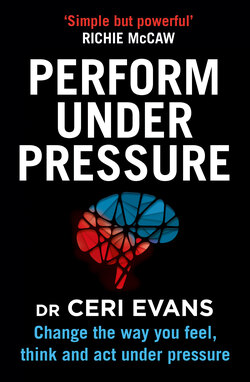Читать книгу Perform Under Pressure - Ceri Evans - Страница 19
The autonomic nervous system
ОглавлениеA well-organised RED limbic system will ensure that we are emotionally stable, flexible and resilient. It will allow us to fine-tune our physical and mental state when we are safe, react quickly to defend ourselves when we are under threat, and settle efficiently once the threat has gone.
It makes these adjustments using the autonomic nervous system (ANS), which, as the name suggests, functions automatically. It’s a RED system based on feeling, so we don’t have to think to turn it on.
The autonomic system has two main branches: the sympathetic branch and the parasympathetic branch. We now know that there are in fact two parasympathetic branches, both related to the large vagus nerves, which run from our brainstem at the base of our skull upward to our facial area, and downward to organs in our chest and abdomen. The two parasympathetic pathways are called the ventral vagal and dorsal vagal pathways. (Ventral means ‘front’ and dorsal means ‘back’, reflecting their relative positions within the nerve.)
The bottom line is that to properly understand how our fight, flight and freeze reactions work – and therefore what’s happening when we perform under pressure – we need to consider how three autonomic branches interact.
The sympathetic branch runs down the middle part of our spinal cord, to connect with our heart and lungs via spinal nerves. It responds to threat by preparing us for movement and action: the fight-or-flight response. To do this, it releases adrenaline, which increases our heart and breathing rates, and shifts blood flow away from our extremities to our limbs. Our vision fixates on the immediate threat. When our sympathetic system is stimulated, we feel agitated and tense.
The dorsal vagal pathway, found in reptiles as well as mammals, connects the brainstem with nerves in the abdomen. Like the sympathetic branch, it responds to extreme danger. But the dorsal vagal pathway is triggered when escape via fight or flight is not possible, so that we feel trapped, which leads to the freeze response. When this pathway is activated, we go into a state of mental and physical shutdown. Mentally, we stop feeling, our thoughts become fuzzy, and we feel alone. Physically, we lose energy, feel fatigued and become numb. If fight–flight is a mobility reaction, freeze is an immobility reaction.
The ventral vagal pathway, also called the social engagement system because it is activated when we feel safe enough to communicate with others, connects (along with some associated nerves) the brainstem to the neck, face, eyes and ears as well as the heart and lungs. It puts the ‘brakes’ on our sympathetic system activation to calm us and allow more flexible responses (except in an emergency, when it releases the brakes). Because it allows us to engage and explore rather than defend and retreat – and to compare it to the defensive fight–flight and freeze reactions – we can think of it as our face and find response: it allows us to face challenging situations, and find a way to overcome the challenge even when the way forward isn’t immediately obvious, which sets us mentally free.
The three pathways work in a predictable order. When we are at our best and feel safe and connected so that the social engagement system is operating, we can connect with others, think flexibly, see different options and follow through with plans, and are generally organised and on top of things. The moment we sense threat, the sympathetic branch of the ANS kicks in and prepares us to defend ourselves through flight or flight. And if neither the social engagement nor the fight–flight mechanism helps and we feel trapped, the dorsal vagal pathway activates the freeze reaction, driving us into a primitive shutdown state.
If our limbic system, working through the ANS, is both stable and flexible, we will be able to maintain a healthy physical and mental state, and also deal with stressful situations.
A poorly organised limbic system, lacking a good balance between the three pathways, leaves us prone to extended periods or abrupt spikes of over- or under-arousal. When this happens, it means our RED brain is overactive and our top-down, BLUE control is inadequate.
